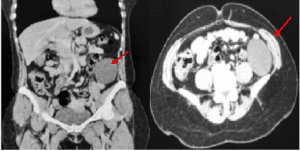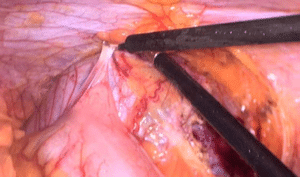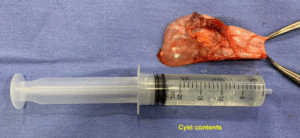Garritano C1*, Leiros T2, Werneck ME3, Penedo LD3, Costa M3, Waechter L3, Rocha RCS4, Drexler M3
1General Surgery, Department of General Surgery of the Federal University of the State of Rio de Janeiro, Brazil
2Surgical Clinic A, Gafrrée and Guinle University Hospital, Brazil
3General Surgery Resident at Gaffrée and Guinle University Hospital, of the Federal University of the State of Rio de Janeiro, Brazil
4Medical Student at the Federal University of the State of Rio de Janeiro, Brazil
*Correspondence author: Célia Garritano, MD, PhD of General Surgery, Department of General Surgery of the Federal University of the State of Rio de Janeiro, Brazil; Email: [email protected]
Published On: 27-11-2023
Copyright© 2023 by Garritano C, et al. All rights reserved. This is an open access article distributed under the terms of the Creative Commons Attribution License, which permits unrestricted use, distribution and reproduction in any medium, provided the original author and source are credited.
Abstract
A mesenteric cyst is a rare abdominal tumor that can be found anywhere in the digestive tract, between the duodenum and rectum. It presents nonspecific symptoms like those of other digestive diseases, which can delay the diagnosis. The preferred treatment is surgery and the lesion should be completely removed to avoid recurrence or other complications. We present the case of a patient with pain and palpable abdominal mass, who was diagnosed with a mesenteric cyst and referred for surgical treatment.
Keywords: Mesenteric Cysts; Abdominal Mass; Surgical Treatment
Introduction
Mesenteric cysts were described for the first time in 1507 by Benevenni, during an autopsy and the first resection was performed in 1880 by Tillaux [1-5].
They are rare tumors, usually benign, which can appear in any part of the gastrointestinal tube, asymptomatic or with nonspecific symptoms and are often diagnosed incidentally in the identification of an abdominal mass, by imaging or in the investigation of abdominal symptoms [1,6,7,8].
The treatment is complete resection of the cyst, either by laparotomy or laparoscopy [1,4,6,7].
Case Report
A 55-year-old female patient reported that approximately 2 years ago she presented pain in the left side of the abdominal region, constantly, with worsening in the left ventral and lateral decubitus and with mild and superficial palpation, accompanied by nausea and postprandial fullness. She also reported getting worse in pain when she had constipation and a full bladder. Denies fever, weight loss or other symptoms. She sought care and was prescribed analgesic and anti-inflammatory and there was no improvement with the medications. The patient also reports that since the onset of symptoms, she noticed the presence of a mass in the abdominal left side that has been showing growth. She was referred to the General Surgery outpatient clinic. On physical examination, she was hydrated, stained, acyanotic, anicteric and with normal vital signs; pain on deep palpation on the left side of the abdominal wall, with the presence of a mobile tumor, not adhered to deep planes and with cystic consistency.
Laboratory tests and chest X-rays were performed, which showed no alterations.
In the computed tomography, there was an expansive formation with a cystic density of thin walls, with discrete parietal calcifications in its posteromedial face, located on the left flank, in close contact with jejunoileal segments, colon and left psoas, measuring 8.2 x 7.5 x 5.4 cm, without signs of contrast impregnation (Fig. 1).

Figure 1: Identification of cystic tumor in the abdominal cavity through Computed Tomography (red arrow).
With these results, the patient was referred for surgical treatment and we chose to perform the surgery by video laparoscopy.
We observed the existence of a tumor with the small intestine loops adhered to it (Fig. 2).

Figure 2: Identification of the cyst adhered to the intestinal loop.
After resection of the adhesions, the tumor presented a cystic consistency with intense vascularization (Fig. 3).

Figure 3: Cystic tumor with intense vascularization.
After the complete release of the tumor, it was placed inside a rubber bag and positioned immediately below the umbilical scar. The pouch was externalized and the cystic contents were then fully aspirated, thus facilitating its complete resection without extravasation of the contents into the abdominal cavity (Fig. 4).
The surgical specimen was sent for histopathological examination. On macroscopy, the material was described as a cystic tumor formation, with thin walls, with marked vascularization. Microscopic examination shows a cystic formation lined internally by cuboid epithelial cells, with a discrete lymphocytic inflammatory infiltrate and intense vascularization. As no signs of malignancy were found, it was concluded that it was a simple mesenteric cyst.

Figure 4: After ressection of the abdominal cystic lesion.
The contents of the cyst were sent for culture and cytological examination and only lymphocytes and mesothelial cells were found. The presence of bacteria, fungi and viruses, as well as neoplastic cells, were not observed in the sample.
The patient evolved satisfactorily in the immediate postoperative period, accepting oral feeding the day after surgery and was discharged from the hospital after 48 hours, in good general clinical condition.
Discussion
The mesenteric cyst is a rare abdominal tumor with a reported prevalence of 1:100,000 in adults, being more common in Caucasians in the 4th decade of life [1,4,7,9,10-12]. They are slightly more common in women although a study carried out by Yavuz and collaborators between 2010 and 2019 showed a predominance of males [7,9,12]. They arise more frequently in the small intestine (66%) than in the large intestine (24%) and while in the small intestine, the ileum is the most common site, in the large intestine it appears more commonly in the ascending colon [6,7,9,11-13].
They are benign lesions and about 3% can turn into malignant tumors [1,7,9].
As there is no defined etiology, several theories are mentioned, such as the proliferation of ectopic mesenteric lymphatic tissue failing to communicate with the core lymphatic system the continued growth of congenitally malformed lymphatic tissue, secondary to trauma, degeneration of the lymph nodes or failure to properly fuse the layers of the mesentery, a blockage in the communication of the lymph nodes with the lymphatic or venous system due to inflammatory and neoplastic processes, trauma or previous pelvic surgery [5,6,9,13].
Because it presents nonspecific symptomatology, chronic abdominal pain, nausea, abdominal distension and alteration of bowel habits which are common in diseases of the digestive tract or the reference of an abdominal mass, the diagnosis of the mesenteric cyst may be incidental through imaging tests to identify the abdominal mass and physical examination in the investigation of symptoms [1,4,6,7,8,11,13].
The usual imaging tests, Ultrasonography (US), Computed Tomography (CT) and Magnetic Resonance Imaging (MRI), are used for the diagnosis. However, the US is not able to clearly show the relationship between the abdominal mass and neighboring tissues, unlike CT and MRI, which, in addition to detailing the location of the mass and its relationship with the surrounding organs, help in treatment planning [1,6,7,12].
In the case presented, the patient maintains the characteristics reported in the literature as the most found, as she is female, in the 4th decade of life, has digestive symptoms and a palpable abdominal mass and the diagnosis was made through CT.
Regarding treatment, although surgery is the method of choice, even in asymptomatic patients other options are reported in the literature [1,6,7,12].
The cyst should be completely removed, avoiding recurrence of the lesion, complications like malignancy, hemorrhage, torsion, obstruction, traumatic rupture and infection and the involvement of neighboring structures and mesentery vascularization should also be evaluated [6,7].
The surgery can be done by video laparoscopy or by laparotomy and the choice of surgical route should be based on the size and location of the cyst, the presence or absence of involvement of neighboring organs and the experience of the surgical team [6]. Some consider the open route to be more indicated due to the possibility of rupture of the cyst and spillage of the contents into the abdominal cavity [7].
It is reported that indocyanine green dye can identify the mesenteric vascular arch through angiography performed during laparoscopy. This procedure can help to identify if, during the resection of the cyst, there was any injury to the mesenteric vessels, compromising intestinal viability It is a resource used in the treatment of large bowel cysts [11].
Some advocate conservative treatment, postponing surgery, based on the idea of avoiding postoperative complications and the possibility of spontaneous regression of the cyst [13]. However, there is no reference in the literature of spontaneous regression and on the contrary, complications may occur, such as the growth of the lesion compressing neighboring organs, adherence to nearby structures, hemorrhage, torsion, rupture and the possibility, although small, of malignancy.
Other options for the treatment of mesenteric cysts would be percutaneous drainage with or without the use of ethanol (through interventional radiology), simple aspiration and marsupialization. However, all can cause recurrence, infection and even malignancy [7,13].
In the present case, we opted for surgical treatment, since the conservative method does not offer safety in relation to future complications or malignancy of the cyst, even though this is a very small possibility. We start with video laparoscopy to evaluate the location, size and presence of cyst adhesion in neighboring structures or any other situation that would make it impossible to perform the procedure. We identified that the origin of the cyst was in the mesentery of the jejunum not being adhered to the adjacent structures and so we proceeded with the method, carefully dissecting it and taking care to aspirate the contents of the cyst after complete release of it. The cist was removed through the umbilicus and no complications occurred during the procedure.
Video laparoscopy allows us to have a better view of the cyst, with less possibility of its rupture, which can occur during manipulation in a laparotomy. In addition, laparoscopy is a less invasive procedure, less painful in the postoperative period, allowing a faster recovery of the patient.
Conclusion
The mesenteric cyst is a rare abdominal tumor and due to the nonspecific symptoms and the presence of an abdominal mass, it is necessary to perform a careful anamnesis and physical examination, in addition to precise complementary tests so that the diagnosis can be made as soon as possible. The treatment of choice is complete surgical resection, thus preventing recurrence and malignancy. The procedure can be performed via laparoscopic video or by laparotomy.
Consent for Publication
Written informed consent was obtained from the patient for publication of this case report and any accompanying images.
Ethics Approval and Consent to Participate
The study was approved by the Ethics Committee of the Gaffrée and Guinle University Hospital.
Conflict of Interest
The authors have no conflict of interest to declare.
References
- Theodoridis TD, Zepiridis L, Athanatos D, Tzevelekis F, Kellartzis D, Bontis JN. Laparoscopic management of mesenteric cyst: a case report. Cases J. 2009;2:132.
- Reis DG, Rabelo NN, Aratake,SJ. Cisto mesentérico:linfangioma abdominal. Rev Med Minas Gerais. 2014;24(3):420-2.
- Nagano H, Kimura T, Iida A, Togawa T, Goi T, Sato Y. Cystic lymphangioma in the peripheral jejunal mesentery in an adult and excision with laparoscopic-assisted surgery: a case report. World J Surg Oncol. 2019;17(1):170.
- Ghielmetti M, Neuschütz KJ, Hirschmann A, Marston K, Steinemann DC, Von SUTM. Idiopathic lymphatic mesenteric cyst of the proximal jejunum: A case report of an unusual clinical presentation. Int J Surg Case Rep. 2022:107402.
- Aliukonis V, Lasinskas M, Pilvelis A, Gradauskas A. Pathological discrepancy: simple mesenteric cyst vs. mesenteric lymphangioma. Case Rep Surg. 2021:8848462.
- Alqurashi HE, Alaryni AA, Alsairafi RA, Alharbi AM, Alaqla AA. Mesenteric cyst: a case report. Cureus. 2023;15(1):e34325.
- Aregawi AB, Alem AT. A rare case of calcified simple mesenteric cyst in a 70-year-old woman. Case Rep Surg. 2022;2022:8692421.
- Xiao Y, Chaudhari S, Khattak T, Tiesenga F. A rare case of abdominal tumor: mesenteric cyst. Cureus. 2022;14(10):e29949.
- Aguirre SV, Mercedes Almagro M, Romero CA, Romero SS, Molina GA, Buenaño RA. Giant mesenteric cyst from the small bowel mesentery in a young adult patient. J Surg Case Rep. 2019;2019(1):rjz002.
- Yavuz Y, Varman A, Şentürk ÜM, Kafadar MT. Mesenteric cyst in 22 cases. J Gastrointest Cancer. 2021;52(3):993-6.
- Wagh AN, Dhimole N, Bhagvat SR, Sholapur SS, Doddamalappa S. Use of indocyanine green-aided real-time angiography in laparoscopic mesenteric cyst excision – A safer approach. J Minim Access Surg. 2022;18(2):317-9.
- Bhattacharjee A, Kulkarni V, Lamture Y, Nagtode T, Ramteke H. A rare case of a mesenteric cyst. Cureus. 2022;14(11):e32015.
- Leung BC, Sankey R, Fronza M, Maatouk M. Conservative approach to the acute management of a large mesenteric cyst. World J Clin Cases. 2017;5(9):360-3.
Article Type
Case Report
Publication History
Received On: 23-10-2023
Accepted On: 20-11-2023
Published On: 27-11-2023
Copyright© 2023 by Garritano C, et al. All rights reserved. This is an open access article distributed under the terms of the Creative Commons Attribution License, which permits unrestricted use, distribution, and reproduction in any medium, provided the original author and source are credited.
Citation: Garritano C, et al. Presentation of a Case of Mesenteric Cyst. J Surg Res Prac. 2023;4(3):1-5.

Figure 1: Identification of cystic tumor in the abdominal cavity through Computed Tomography (red arrow).

Figure 2: Identification of the cyst adhered to the intestinal loop.

Figure 3: Cystic tumor with intense vascularization.

Figure 4: After ressection of the abdominal cystic lesion.


